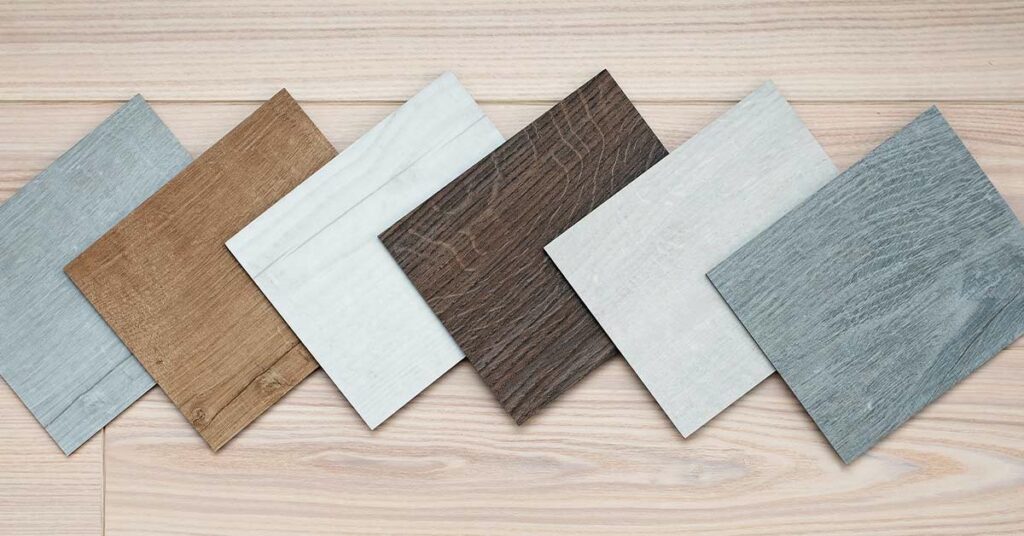
If you’re in the market for new floors, you might be surprised by the many tile flooring options available these days. Luxury vinyl tile (LVT) is manufactured to have similar visual appeal to tile. Whether homeowners choose tile or LVT, chances are they will not have any trouble finding flooring material to suit virtually any type of interior design style. Both tile and LVT have advantages and drawbacks. Do you know which one you want to select? The answer to this question depends on what features are most important to you. Let’s take a look at both types of flooring.
About Tile
Throughout history, interior design styles have come and gone, yet in many cases, existing tile is left in place for decades or even centuries. It’s practical. It’s elegant. You can choose from many different sizes and shapes, from sleek and modern large format tile to more traditional tile. The performance of various tile types can vary based on the manufacturing methods and the materials used in their production.
Porcelain
From homes with children and pets to those with retirees and empty nesters, porcelain tile floors can be conducive to a variety of lifestyles. Homeowners who value durability, versatility, and low maintenance flooring material tend to go for porcelain. Porcelain resists scratches and stains and spills and pet accidents are easy to wipe up.
Ceramic
Although not as dense as porcelain, ceramic tile can be a great option for budget-conscious homeowners. Just don’t expect this material to perform as well as porcelain when it comes to staining and wear. Ceramic must be glazed or sealed since it is so absorbent.
Natural Stone
The great thing about natural stone is that it can be restored to like-new condition over and over again. Although more porous types of stone are prone to staining, penetrating sealers can give homeowners enough time to clean up messes before they are absorbed into the stone’s surface. If not, the poulticing method of stain removal usually works well.
Terrazzo
This flooring material is made by combining aggregates (little pieces of stone, glass, or recycled materials) with cement or epoxy resin. Throughout history, terrazzo has been poured at the installation site, but in its modern tile form, terrazzo is easier to transport and install. Epoxy-based terrazzo tiles are not absorbent, therefore stain resistant. Cement-based terrazzo is porous, but it can be sealed or natural stone. Alternatively, topical coatings can be applied, but the floors will need to be periodically stripped and recoated.
Cement
Made of portland cement and fine sand, colored cement tiles are a durable and eco-friendly flooring material. Hand-made, artisan cement tiles have a lot of character, whereas hydraulic-pressed cement tiles are more uniform in appearance. Both types are of higher quality than their budget-friendly alternative, machine-made cement tiles.
Terracotta
A popular choice of flooring material for Mediterranean, Spanish, and southwestern-style homes, terracotta tiles are made from natural clay. This porous material is not suitable for wet areas and must be sealed to inhibit staining. The cost of terracotta tiles varies depending on the quality of clay and the manufacturing process.
Quarry
Like terracotta tiles, quarry tiles are made from natural clay. Quarry tiles are fired at higher temperatures than terracotta, resulting in a more dense and durable composition, suitable for interior and exterior use.
Glass
Glass tile can be reflective, colorful, and downright stunning, but if you select glass tile for your new floor there are a few things you should know. Glass tiles tend to be expensive, and since they are more challenging to install, you can plan on paying more for installation. They are usually used for swimming pools and tub surrounds, backsplashes, walls, and alongside other types of tiles as decorative or artistic elements. Glass tiles can be used on floors, but it would be best to do so only in low-traffic areas, where scratch damage will be minimal.
About LVT
LVT is a robust, durable flooring material made of PVC plastic, fiberglass, or a wood-plastic composite. It is often designed to look like other materials, such as tile and stone. Luxury vinyl planks (LVP) is plank-shaped LVT made to look like wood. LVT is manufactured in layers. The bottom layer is a backing material. The next layer is decorative, printed with a pattern or design. A clear, protective layer covers the design.
There are several different ways LVT can be installed. Like ordinary vinyl tiles, LVT can be glued down or installed via a click-and-lock system. Unlike regular vinyl tiles, LVT can be a floating floor system or a loose-lay installation, which eliminates the need for adhesives or nails.
Regardless of the installation system, subfloor flatness is incredibly important. If the subfloor is not flat, LVT can break and fall apart.
Comparing LVT to Tile
Some of the most obvious considerations, when comparing LVT and tile, are visual aesthetics, underfoot satisfaction, and the amount of use you can expect to get from your flooring before replacement is needed.
Appearance
There are so many considerations regarding the appearance of your flooring material. Are you looking for wood or stone textures? Do you have specific colors or patterns in mind? What is your preference on the level of reflectivity? LVT and tile both offer a broad range of textures, colors, designs, and finishes. Tile, however, brings timeless elegance to a space. Natural stone tiles have unique patterns and veining if you’re looking for a truly unique material.
Comfort
Softer, warmer, and quieter underfoot, LVT wins the comfort contest. Tile is hard. There’s no way around it. Both LVT and tile can both accommodate underfloor heating systems. With either type of flooring material, professional installation and adherence to manufacturer’s guidelines are important for your safety.
Durability
With proper installation, LVT and tile are both durable flooring options. Overall, LVT will not last as long as tile. Many types of tiles can be refinished or restored to like-new condition. For example, porcelain and ceramic can be reglazed, natural stone can be refinished, and any type of tile that takes a topical coating can be stripped and recoated.
Where will flooring be installed?
When choosing between LVT and tile flooring, consider factors like humidity levels, temperature fluctuations, UV exposure, and moisture. How much water inevitably finds its way onto the floor in a bathroom or kitchen?
Moisture
LVT and LVP will perform well in areas with moderate changes in humidity and temperature, but luxury vinyl cannot withstand high or constant moisture. For areas with high humidity, moisture, and extreme temperature changes, tile is your best bet.
Bob Goldstein, a second-generation flooring professional with five decades of experience, wrote an interesting article, “What I’ve Learned as an Inspector for ‘Luxury Tile’ Flooring.” Goldstein recommends a simple test for any so-called “waterproof” LVP:
“Take two like pieces of LVP, click them tightly together, and lay them down on paper such as paper towels or newspaper. Pour water on the seam and let it sit until the water is gone.” Look under the planks to see whether water has made its way through.
And here is an LVT moisture test Goldstein recommends:
“Get four or five sample planks and lay them on a flat surface after ensuring they started with no cupping or other issues.” Wait for about a week to see whether the planks have become cupped, that is, curved upward around the edges.
UV Exposure and Fading
The level of UV resistance LVT offers will vary from one product or manufacturer to another. Most natural stone is UV resistant, but certain types of stone will need to be sealed to prevent fading. Check the product information before making a purchase, if you expect a lot of sun exposure.
Care and Maintenance
Both LVT and tile can be sanitized effectively. As with any surface, proper cleaning and maintenance of your flooring is important for a healthy living environment. Use high-quality walk-off mats at doorways to minimize the amount of abrasives tracked in on shoes.
Harsh chemicals, abrasives, and soap-based cleaners can damage LVT and many types of tiles. Follow the recommended cleaning and care instructions from the product manufacturer.
Tile floors will need periodic professional attention. Properly maintained LVT flooring may not require professional cleaning, but with high traffic and use, you may opt to hire someone for convenience sake.
For more valuable tile care and maintenance information, read our article, How Do I Keep My Tile Looking New After Installation?
Cost
LVT is cheaper and easier to install than tile. Although tile generally has higher material and installation costs, it lasts longer. So when you factor in the cost of replacement, it levels the playing field somewhat. Consider both your immediate budget and your long-term plans when deciding between LVT or tile. You many also be interested in reading this article: How Materials and Other Factors Influence Labor Costs.
When choosing between LVT and tile, select the material that aligns best with your design preferences and priorities. Please feel free to reach out to us with specific questions or suggestions regarding material selection.
Related reading: Real Wood vs Wood-Look Tile Floors
by Alice Dean
Copher Tile & Stone proudly stays up to date on tile floor installation with ongoing education with Mapei Technical Institute, Ardex Academy, the National Tile Contractors Association, Laticrete, and Schluter. Copher is a Certified Tile Installer (#1644).

